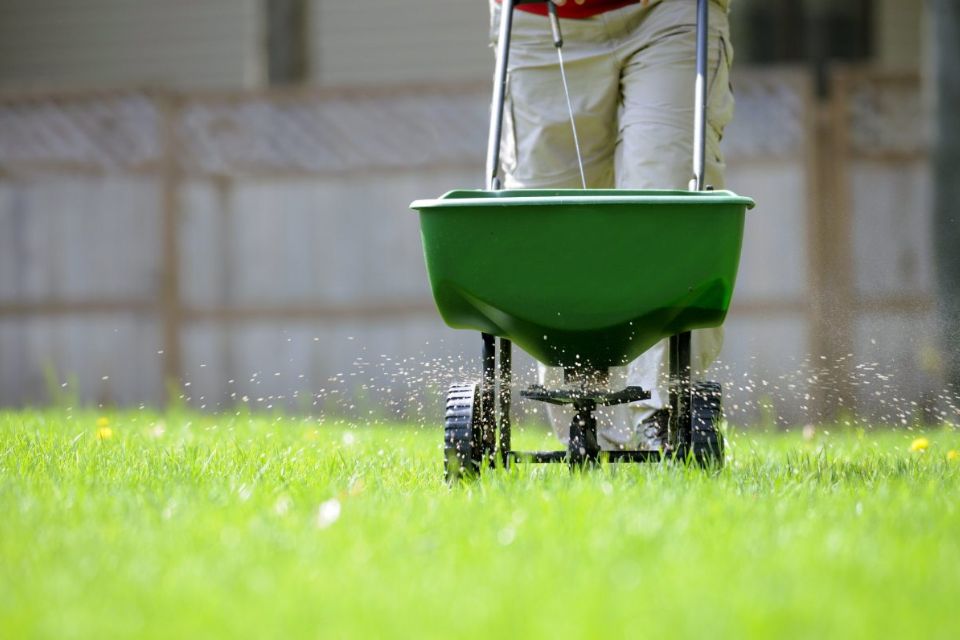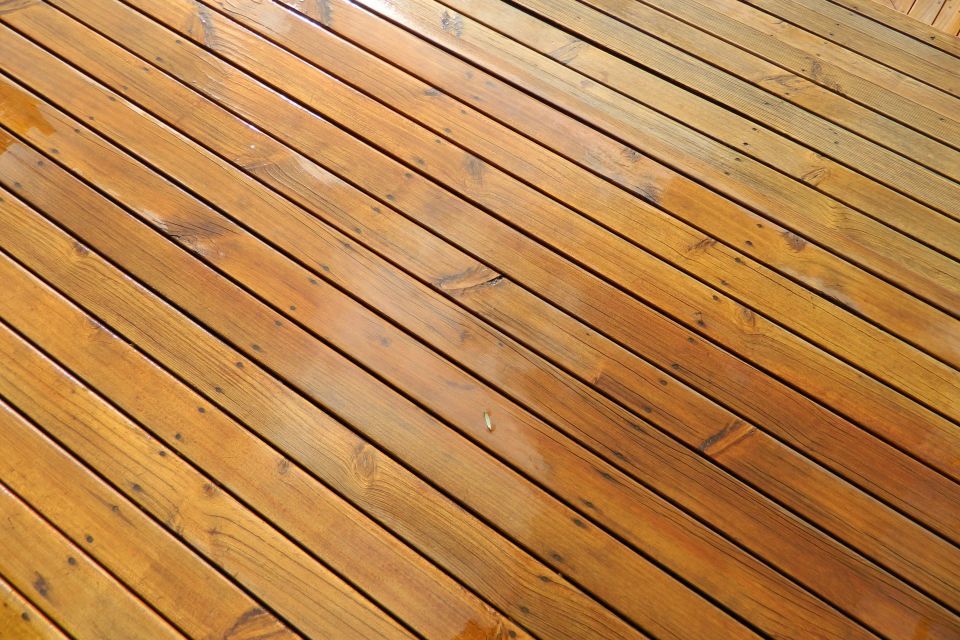Introduction to the Best Lawn Spreader
Throughout this article, we will help you find the best lawn spreaders on the market. Our guide will explain the features of each model and give additional details such as their pros & cons.
We’ll also explore topics such as how a lawn spreader works and the estimated cost of hiring a gardener. This guide will prove very useful if you’re trying to find the best lawn spreaders in the UK!
What is a Lawn Spreader?
First, let’s consider what a lawn spreader is and what it’s used for. Also known as a lawn seed spreader or lawn feed spreader, a lawn spreader is a garden tool used to evenly distribute materials like grass seed and fertiliser onto a lawn.
Lawn spreaders generally feature a bucket, also known as a container or hopper where the material is housed, two wheels and a tall handle for a push or pull motion when being used or transported.
However, some lawn spreaders exist as simple handheld tools, featuring a small bucket and an easy to grip handle attached to the back of the bucket. They are used to distribute materials evenly and in just the right amounts.

Some lawn spreaders have an adjustable spread rate option, meaning that you can tailor its functions to your lawn’s needs.
Ultimately, the purpose is to provide a faster and far more accurate approach to applying seed or fertilising a lawn compared with doing it by hand.
They may be needed if your lawn is struggling to grow or if it’s full of dead patches that require re-seeding.
How Does a Lawn Spreader Work?
We will now explore the workings of a lawn spreader in more detail. How a lawn spreader works will depend on the type of lawn spreader in question.
In the case of a drop spreader, many of these products release materials at a fixed rate meaning that how fast you walk will determine how much fertiliser, grass seed, etc. is spread onto a lawn.
However, there are drop spreaders with adjustable spread rate settings. The key feature of a drop spreader is that it drops materials directly from the bottom of the container.
Broadcast spreaders allow you to apply seeds, fertiliser and other materials in greater quantities at any given time. This is due to the fact that they release materials from their left, right and sides.
Rotary spreaders distribute materials in a specific pattern, such that the heaviest rates land in the centre of the spreader path with less matter distributed to the left and right of the central application area. They also tend to come with adjustable spread rate settings.

Before using a lawn spreader, you’ll need to fill it up with the materials of your choice in accordance with the manufacturer’s guidance. With any lawn spreader, you need to ensure that it is prepared for work and that any settings are tuned to your preferences.
In the case of a rotary lawn spreader, you’ll need a significant overlap when walking up and down your garden of around 30-50% due to their unique distribution pattern.
You should also decide what setting you want to go with. For a broadcast lawn spreader, with the correct setting, it will distribute materials at a given rate that you’ve chosen.
You should start with the setting suggested by the manufacturer and then it will be a case of learning as you go, to figure out what setting best suits your garden and preferences.
Once you’ve decided what the ideal setting is, make sure to write it down so you can remember it for next time.
In the cases of both a lawn drop spreader and broadcast lawn spreader, you should still overlap on each pass although to a lesser extent as you would with a rotary spreader.
Types of Lawn Spreader
Before purchasing a lawn spreader, you need to consider which type you prefer. To help you decide, here is a breakdown of the different types of lawn spreader, including the costs and the pros and cons of each.
Rotary
This type of lawn spreader comes with a fan beneath the materials container. The fan is used to achieve the unique rotary spreader distribution pattern as it rotation results in more material landing in the central region of the spreader’s path.
Rotary spreaders also tend to feature an adjustable spread rate option, giving you more control over the use.
Preferably, if you’re looking for a rotary lawn spreader, it should have pneumatic tyres to make its use as smooth as possible.
 <
<Rotary spreaders are not suitable for distributing weed and seed products. This is because such products can kill plants and with the nature of a rotary spreader, it can be difficult to prevent unintended contamination.
You should practice distribution on a concrete area first to figure out what spread rate setting suit your preferences. Start with the manufacturer’s recommendation and then adjust it further if necessary until you are satisfied with the results.
Pros:
- Fast-acting.
- Offers a unique spread pattern.
Cons:
- Not suitable for use with weed and seed products.
A rotary lawn spreader will typically cost around £30
Broadcast
While offering a similar distribution pattern to a drop lawn spreader, broadcast spreaders drop seeds in more directions than a drop spreader.
As with a rotary spreader, you should practice with a broadcast spreader by applying materials to a concrete surface to figure out what spread rate setting you want to go with.

A broadcast spreader can apply seeds or fertiliser over a large area as it releases material from its front, bottom and sides, all at the same time. You may push along a broadcast spreader by yourself or tow it with an ATV or lawn mower.
One con is that broadcast spreaders are not as accurate as drop spreaders.
As with a rotary spreader, you should not use weed and seed products with this type of spreader.
Pros:
- Provides a fast spread.
- Covers significant surface areas at any one time.
Cons:
- Not as accurate as a drop spreader.
A broadcast lawn spreader will typically cost around £40
Drop
Drop spreaders release materials only from the bottom compartment. While they tend to have an adjustable drop rate dial, they release materials over a small area at any one time.
The major upside to this is that while they take longer to use, they are generally more accurate. With a drop spreader, the risk of applying seeds, fertiliser and so on to unwanted areas of your garden is more limited.

Drop spreaders are generally less expensive too. Unlike the latter two spreaders, a drop spreader is suitable for applying a weed and seed product.
Pros:
- Very accurate.
- Minimal risk of distributing materials onto unintended spaces.
- Suitable for applying weed and seed products.
- Generally more affordable.
Cons:
- Slower to use.
A drop lawn spreader will typically cost around £50
Best Lawn Spreaders
There are many different lawn spreaders to choose from, here we have whittled down the best six for you. Here they are:
EverGreen Easy Spreader Plus
Perhaps the best lawn spreader on the market is this highly-rated model from EverGreen.
It is designed for straightforward distribution of lawn treatment products from EverGreen as well as lawn seed. This drop spreader features adjustable settings and a complex dispensing mechanism.
Assembling this lawn spreader is also simple. Its on/off switch makes for a safe turn-around.

One downside to this switch is that it's located on the bucket, so it can’t be turned off as quickly as with other models.
As a drop spreader it's a great choice for the application of weed and seed products.
The Easy Spreader Plus is perfect if you need to complete an especially accurate job.
You should use this spreader between March and November. As a drop spreader, it needs to be pushed along or pulled to distribute one trail of material.
It’s also promoted as an easy to use lawn spreader with a 4.3 star rating on Amazon for ease of use. Expect to pay around £24 for this product.
Pros:
- Highly accurate.
- Easy to use and without the need for manual rotation.
- Comes with an off/off switch.
- Suitable for applying weed and seed products.
- Easy to assemble.
- Not very expensive.
Cons:
- With the on/off switch lever on the container, it can’t be turned on and off very quickly.
- You need to use Evergreen and Miracle-Gro lawn treatments with this model.
- Slower than a broadcast or rotary lawn spreader.
Scotts EasyGreen Rotary Spreader
This next product is a popular rotary lawn spreader. With a spreading width of 122cm to 340cm, the EasyGreen Rotary Spreader is suitable for fast jobs and for covering large surface areas.
EverGreen is also behind this product. It is very well suited to a large lawn.
It comes with an adjustable handlebar which can make working with this rotary spreader more comfortable and makes storing it very easy.
As with most lawn spreaders, it too has adjustable spread rate settings.
It has a steel frame, plastic container and a plastic hopper. It should only be used with grass seed products, Evergreen and Miracle-gro granular care or/and Lawn Builder.

One downside is that while it can be used quite fast, it is not going to be as accurate as products like the EverGreen Easy Spreader Plus since it is a rotary spreader. It should be used between March and November.
This lawn spreader needs to be used with the nature of a rotary spreader in mind.
First, adjust the settings in accordance with your preferences before covering one stretch of the lawn. When you reach the end of the first pace, turn it off.
Face it back towards the lawn but position it such that it straddles the edge of the previous covered length by 30% to 50% before powering this lawn spreader back up and moving ahead to continue use. Repeat this process until you’ve covered every surface you’ve intended to.
Do not use a weed and seed product with this lawn spreader. Its adjustable handlebar contributes to the ease of use offered by this spreader.
This rotary spreader will set you back around £30 to £40.
Pros:
- Offers a fast distribution of materials for large surface areas.
- Very well suited to a large lawn.
- Features an adjustable handlebar.
- Fast and effective.
Cons:
- Not as accurate as drop spreaders.
- Not suitable for distributing weed and seed products.
- A little expensive.
- Can only be used with certain products.
Scotts Miracle-Gro EvenGreen Drop Spreader
Another spreader offered by EverGreen is this popular drop spreader. It also comes with an adjustable handlebar for convenient use and storage. It features variable settings and a handy on/off switch that is easy to reach.
One downside is that it can only be used with grass seed products or/and Evergreen and Miracle-Gro granular lawn care. It provides a spreading width of 45cm. You’ll find many positive lawn spreader reviews associated with this product.
As a drop spreader, while it is more accurate, it is not as fast as rotary or broadcast spreaders. You can use the Miracle-Gro EvenGreen Drop Spreader between March and November.

As with the Easy Spreader Plus, to use this lawn spreader, push forward with the power on and upon reaching the end of a given stretch of lawn, turn it off, and then face it towards the lawn.
It should be slightly straddling the edge of the previous track before powering it back up and resuming. Repeat this process until you’ve completed the job.
It’s also another easy to use product. You may use a weed and seed product with this lawn spreader.
It costs around £30 to £35 to buy this model.
Pros:
- Popular product.
- Comes with an easy to reach on/off switch.
- Features an adjustable handlebar making it easy to use.
Cons:
- Unsuitable for use with most lawn products.
Earthway Ev-n Spred 2150 Broadcast Spreader
One of the top broadcast spreaders on the market is this model from Earthway.
This highly durable broadcast spreader features a 23kg capacity poly bucket and 33cm pneumatic stud type tyres with rust-resistant properties.
The Ev-n Spred 2150 Broadcast Spreader comes with a 3-hole drop system enabling for a greater distribution of materials than is offered by models like the Miracle-Gro EvenGreen Drop Spreader.
However, it offers less accuracy since it’s a broadcast spreader. Another downside is that weed and seed products cannot be used with this spreader.

See Earthway’s handbook for information on when this spreader should be used.
Before use, set the spread rate settings to the correct level. Push the spreader from behind with its height-adjustable handlebar. Cover a given track.
Turn it off. Turn it around and ensure that you are slightly straddling the line of the previous track. Power it back on and continue. Repeat this process until you feel satisfied that you’ve covered everywhere you intended to.
This Earthway lawn spreader is easy to use and manoeuvre. It should be noted however, that this spreader is quite expensive. Cost-wise, this product will land around £280 to £300.
Pros:
- Comes with an adjustable handlebar.
- Features rust-resistant properties.
- Has a durable poly bucket with a capacity of 23kg.
- Wide and fast distribution of materials.
Cons:
- Not cheap.
- You can’t use weed and seed products with this spreader.
Scotts EverGreen Handy Spreader
This next product is an example of a handheld lawn spreader. It represents great value for money with a cost of only £15.
As a small and light product, it’s of course, very easy to store away after use.
With this product, the materials inside the container are released from small holes as you turn a handle manually.
The handle used to maintain a grip of this spreader is attached at the back end of the container.
Despite its low-price, it still features adjustable spread rate settings.
Its compact size makes it a great choice for applying seeds or fertiliser to a small lawn. It offers a spreading width of two metres.

It won’t take very long to cover a small garden using this spreader which is beneficial as using a handheld spreader for too long could cause a strain on your arm.
With that being said, its built-in arm support will also help in this regard.
Downsides to this product include that it is only suitable for use with EverGreen lawn products and it is not suited for use on a large lawn.
For information regarding when you should use the EverGreen Handy Spreader, see the accompanying handbook.
As a handheld spreader, using it is extremely easy. To use this spreader, pick a suitable starting point and then begin to churn out the seeds, fertiliser, etc. by turning the handle as you walk in a straight line.
Stop turning the handle as you reach the end of the lawn. Turn around and do the same on the next path of the lawn while slightly overlapping the previous path.
It’s not going to be as accurate as say a drop spreader. Repeat this process till you’ve covered the entire lawn or all areas you need to cover.
Pros:
- Very inexpensive and easy to use.
- Great for quick jobs on a small lawn.
- Can be stored very easily.
- Comes with built-in arm support.
Cons:
- You can only use EverGreen products with this lawn spreader.
- Not suitable for use on a large lawn.
Agri-Fab AG45-0462 Broadcast Smart Spreader
This product contrasts the EverGreen Handy Spreader both in quality and price.
The AG46-0462 has nearly a 60kg capacity and features a corrosion-resistant poly hopper for fast distribution of materials.
You can accurately set its spread rate using its professional quality controls. Its large pneumatic tyres provide traction and make the spread easy to manoeuvre despite its size.
It also features an entirely enclosed commercial-grade gearbox.
Since it’s a broadcast spreader, it still lacks the accuracy offered by a drop spreader, even if it is faster. Also, you should not use a weed and seed product with this model.
One major upside to this spreader is that you can cover more than half an acre with it! It’s designed for professional use to cover a large surface area.

For a small lawn, you won’t need to spend so much to find a suitable lawn spreader for your garden.
For information on what months of the year to use this spreader, see the manufacturer’s handbook.
To use this broadcast spreader, ensure that the spread rate setting is to your liking before turning it on and covering one path at a time of a given surface area. Turn the machine off and back on again with each turn.
Make sure that you straddle the line of the previous path covered. This way you’ll make sure not to miss any spots.
Keep going until you’ve covered every patch of land you intended to. Its height adjustable handlebar makes it easy to push and helps with manoeuvering. The latter is also made easier by the spreader’s large pneumatic tyres.
The AG45-0462 costs around £250 to £300.
Pros:
- A top quality broadcast spreader.
- Features a corrosion-resistant container.
- Ideal for large areas.
- The AG45-0462 can cover more than half an acre.
Cons:
- Expensive lawn spreader.
Benefits of a Lawn Spreader
Lawn spreaders come with many advantages. In each of the following subsections, we will lay out why you should buy a lawn spreader.
Distribution of Seeds
Lawn spreaders can distribute different lawn materials like seeds and fertiliser.
In the case of seeds, it allows for a more accurate application than if you were to simply throw or sprinkle them around the garden by yourself manually.
Lawn spreaders can offer accuracy or speed, depending on what quality you care most about with the prior quality best offered by drop spreaders and the latter by broadcast and rotary spreaders.

Either way, you can expect any lawn spreader to be more accurate than an entirely manual approach.
The main advantage of any level of improved accuracy as it increases the chances of seeds germinating on any given patch of land which will result in a healthier surface.
Distribution of Fertiliser
Just as lawn spreaders can offer a better and more even distribution of seeds, they can offer the same with fertiliser.
Achieving the right sort of distribution of fertiliser is important to reduce the risk of uneven feeding, an unhealthy lawn and other forms of lawn damage.

The greater the accuracy of fertiliser application, the healthier you can expect a garden or land area to be.
Covering Large Surface Areas with Lawn Materials
Many lawn spreaders are great for covering large surface areas.
Obviously, you’ll need to find the right product for your requirements but there are plenty of high-quality lawn spreader models that can cover large lawns and large open spaces, such as the Agri-Fab AG45-0462 Broadcast Spreader.

As discussed, the AG45-0462 can cover over half an acre of land.
So whether you have a large vegetable farm or a big garden, there are lawn spreaders out there that will fit your needs.
Cost of Hiring a Gardener
You may choose to hire a gardener to use a lawn spreader in your garden.
Generally, a gardener will set an hourly rate of between £15 and £50 with the price ultimately depending on where you are located in the UK.

This hourly rate makes up the labour costs of gardening work.
Additional costs you can expect to incur are any supply costs and waste removal costs.
FAQs
Q: What is the best lawn spreader?
A: The EverGreen Easy Spreader Plus is one of the best lawn spreaders on the market. However, it is only one of many high quality products.
Further, it is a drop spreader and you may be looking for a spreader that offers speed over accuracy. In this case, you might like the Earthway Ev-n Spred 2150 Broadcast Spreader which is another highly-rated and popular lawn spreader.
Q: How long does it take newly sown grass seeds to germinate?
A: It may take anywhere from five to thirty days for new grass seed to germinate.
Q: What is a handheld lawn spreader?
A: A handheld lawn spreader is a spreader that features a small bucket with a handle attached at the back. It comes with a handle that you can manually turn to spread fertiliser or lawn seeds for example, onto a lawn.
Q: When should I use a lawn spreader?
A: You should spread your lawn annually in February or March.
Most lawn spreaders are suited to use between March and November while some models are designed for all-year use.
Q: What are some of the best lawn spreader brands?
A: EverGreen, Earthway, Westland and Agri-Fab are some of the best sellers of lawn spreaders.
Sources
- https://www.milorganite.com/blog/Lawn/spreader-settings
- https://ag.umass.edu/turf/fact-sheets/rotary-spreader-calibration-procedures
- https://www.solutionsstores.com/knowledge-base/lawn-care/pros-cons-of-different-types-of-lawn-spreaders
- https://www.lawnsmith.co.uk/topic/fertiliser-advice/rotary-drop-fertiliser-spreaders







